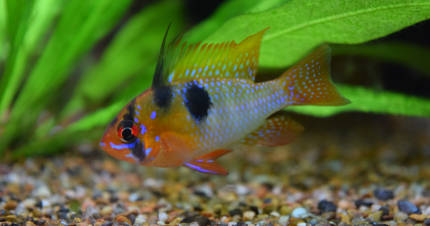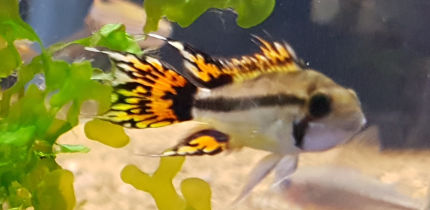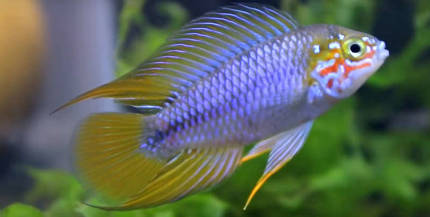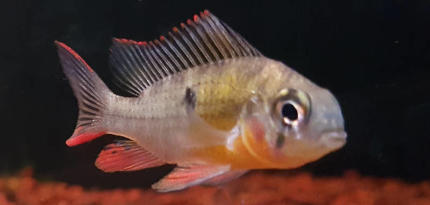About German Blue Rams
German Blue Ram, scientifically known as Mikrogeophagus Ramirezi, are popular due to their dynamic colours and engaging behaviours.
They are not too difficult to keep and can be a great colourful addition to an aquarium.
German Blue Ram Profile
Origin: German Blue Rams originate from the Rio Orinoco drainage in Venezuela and Colombia.
Size: Female: up to 1.5 inches (4 cm), Male: up to 2 inches (5 cm).
Minimum tank size: 20 gallons (75 litres).
Tank region: Bottom half of the tank.
Water temperature: 75 - 85 °F (24 - 29 °C)
Water conditions: PH between 5 to 6 is desirable but up to 7 is ok for aquarium raised fish. Soft water with a low TDS is preferred.
Difficulty to keep: Intermediate level
German Blue Ram Natural Habitat
The German Blue Ram originates from the Orinoco River basin in Venezuela and Colombia, South America.
In their native environment, German Blue Rams inhabit slow-moving streams, gentle tributaries, and flooded forest regions. These areas often feature sandy or muddy substrates combined with pockets of leaf litter, providing both shelter and feeding opportunities.
Understanding the German Blue Ram's natural habitat is pivotal for successfully keeping them in captivity. To replicate their environment, consider providing a fine substrate, using wood and rocks in the aquarium to provide structures and hiding spots, and water parameters that align with those found in their native waters.
German Blue Ram Behaviour and Personality
German Blue Rams exhibit captivating personalities and behaviours which make them a popular choice among aquarium enthusiasts. Renowned for their unique social dynamics, these cichlids often form monogamous pairs and engage in intricate courtship rituals.
Despite their small size German Blue Rams are known for their feisty yet peaceful demeanour. They gracefully navigate the middle and lower regions of the aquarium, showcasing their vibrant colours and intricate fin displays.
Males can be territorial, especially during breeding, where they meticulously prepare and guard a spawning site.
During courtship, these cichlids become animated, displaying vivid hues and performing charming dances to attract potential mates. Their interactions are fascinating to observe, as they communicate through subtle body movements and colour changes.
In community tanks, German Blue Rams generally coexist well with other peaceful species, yet they can assert themselves if they feel threatened. Providing ample hiding spots and visual barriers helps create a secure environment, reducing stress and promoting their natural behaviours.
Their interactive nature, stunning colours, and intriguing behaviours make German Blue Rams a delightful addition to well-maintained aquariums.
German Blue Ram Male vs Female
Male and female German Blue Rams exhibit notable distinctions in both coloration and fin morphology.
These differences become particularly pronounced during breeding, as males intensify their colours and fin displays to attract and court potential mates.
Males
Males boast more intense and vivid colours, with prominent extensions in their dorsal and caudal fins. Their bodies showcase iridescent blue markings and richer shades of red, and yellow.
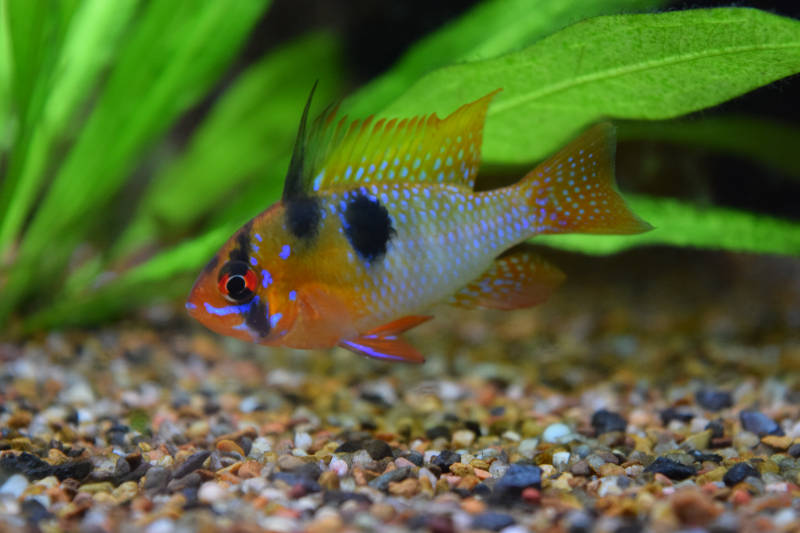
Females
Females are generally smaller, displaying more subdued hues. While their colours are less intense, females feature a pinkish belly, and their dorsal and caudal fins are shorter.

What To Feed German Blue Rams
When feeding German Blue Rams you should aim to provide a balanced diet that promotes their health and vibrant colours. These dwarf cichlids are omnivorous, meaning they eat both animal and plant-based foods.
Start with high quality pellets or flakes formulated for tropical fish to provide essential nutrients. Consider specially formulated cichlid pellets, I find small slow sinking pallets 1.5mm or smaller in size work well.
I regularly feed Hikari Micro Pellets, they are suitable for German Blue Rams and many of their tank mates such as tetras.
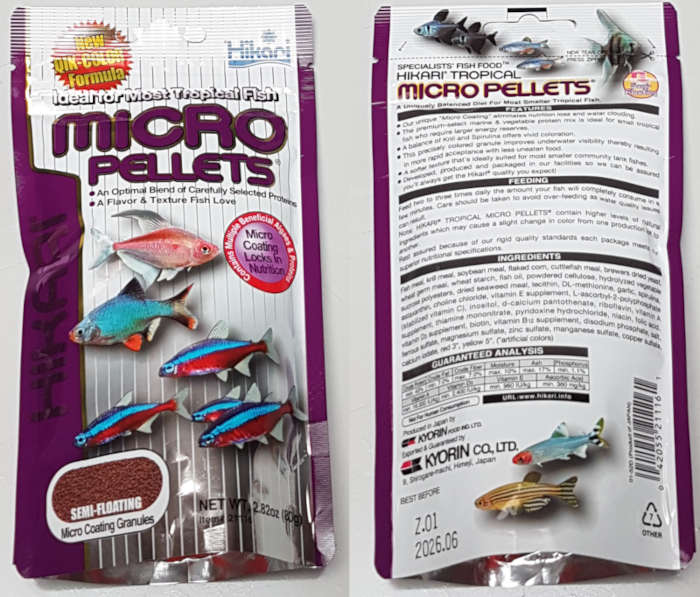
To replicate their natural diet, supplement dry foods with live or frozen foods. Brine shrimp, bloodworms, daphnia, and small insects are excellent protein sources that encourage their hunting instincts.
Feed small portions two times a day, as their small stomachs can't handle large meals. Avoid overfeeding, which can lead to health issues and poor water quality.
By feeding your German Blue Rams a well rounded selection of food that includes pellets, live, and frozen foods, you provide them with the nutrition they need. This will enhancing their overall well-being and help in showcasing their natural behaviours in your aquarium.
German Blue Ram Aquarium Setup
Tank Size
I suggest a 20 gallon (75 litre) tank for a pair or trio of German Blue Rams this allows for some tank mates which will not only make the tank more appealing but tank mates also help make the German Blue Rams feel more comfortable and safe in the knowledge that other fish are around.
Substrate
A fine substrate such as sand or very small gravel is recommended as this is what is commonly found in the natural habitat of German Blue Rams.
This will help to bring out the German Blue Rams natural behaviours which can include sifting the substrate for food.
Aquarium Layout
It is recommended to include driftwood, rocks, and plants in the aquarium as they add structure to the aquarium. These structures can help to provide hiding spots as well as separate the aquarium into different areas should some fish want somewhere to rest.
The different areas separated by structures which break up the line of sight also help to divide the aquarium into separate territories. This is useful in larger aquariums where there is more than 1 one male German Blue Ram as males can become territorial especially when breeding.
German Blue Ram Tank Mates
When selecting tank mates for another fish I try to look for fish that are interesting either in behaviour or appearance and with different colours so that the aquarium will be interesting and attractive. So some part of the tank mate selection comes down to personal preference.
Another key consideration when choosing tank mates is there suitability to the same water conditions. As the fish will be in the same aquarium with the same water it makes sense to select tank mates which also thrive in those water conditions which for German Blue Rams is PH between 5 7, preferably soft water with a low TDS and a temperature between 75 - 85 °F (24 - 29 °C).
Recommended tank mates for German Blue Rams:
- Dwarf Pencilfish
- Ember Tetra
- Rummy Nose Tetra
- Prasilla (X-Ray) Tetra
- Cardinal Tetra
- Sterbai Corydoras
- Otocinclus
Breeding German Blue Rams
-
Select a Breeding Pair
To start breeding you will need a healthy male and female who are sexually mature. German Blue Rams are usually sexually mature around the time they are 6 months old.
-
Breeding Tank Setup
As a minimum I recommend a 20 gallon tank, itprovides enough room should the pair start to get aggressive and need a hiding place or two.
For a breeding tank setup I recommend a bare bottom tank as it is easier to clean.
Provide hiding spots and potential spawning sites by adding a cave, and smooth rocks. Java moss is a good plant to include, as well as providing hiding spots it is home to micro organisms which can provide an initial source of food to young fry.
-
Water Chemistry
Ensure water parameters are appropriate this means soft slightly acidic water with a ph between 5 and 6.5 for breeding.
-
Conditioning
The pair should be conditioned for breeding, this means ensuring that they are both strong and healthy.
To get your German Blue Ram pair in good condition for breeding I recommend feeding high protein live foods such as brine shrimps.
-
Breeding Behaviour & Courtship
The male will initiate courtship by displaying vibrant colours and perform fin movements and displays to attract the female. When ready to spawn the female will become a brighter yellow and her pink belly will be evident.
-
Spawning
Occurs with the female laying eggs a smooth rock, in a cave or even in a pit in the substrate. The male will follow swimming over the eggs fertilising them, this continues until the female has laid all her eggs.
-
Egg Care
The male guards the eggs and both the male and female will guard their territory. The eggs usually hatch within 3 days, and the parents continue to protect them.
-
Raising Fry
Once the fry (baby fish) hatch, they will cling to surfaces around the spawning site and initially feed on their egg sacs. Once their egg sacs are condumed, you can feed them infusoria or microworms. Gradually introduce more suitable foods as they grow.
-
Parental Care
The parents will continue to protect the fry and defend their territory. Keep in mind that parental care behaviour can vary. At this stage it is sometimes necessary to remove the male or even both male and female if there are signs of aggression
-
Free Swimming Fry
Once the fry are free-swimming and independent, they can be separated from the parents this will prevent any aggression or cases of the parents eating the fry. At this stage I recommend feeding baby brine shrimp.
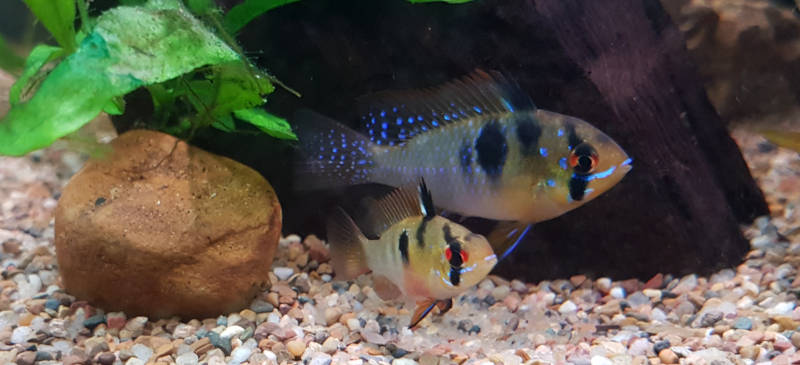
Conclusion
German Blue Rams can be a wonderful addition to many aquariums. They have stunning colours and interesting personalities which can make them a centre piece of the aquarium.
They are not too difficult to keep and with some consideration to aquarium layout, water parameters and maintenance they can thrive and be rewarding to keep in an aquarium.
FAQ
Why Are German Blue Rams So Popular?
German Blue Rams are popular in the aquarium hobby as they are a small fish with interesting personalities and behaviours. They are also one of the most colourful tropical fish for their size featuring iridescent blues with rich yellows and oranges on their body.
Are German Blue Rams Difficult To Keep?
I rate German Blue Rams as an intermediate fish to keep mainly as they can be sensitive to water parameters hence water parameters should be within the appropriate ranges.
They should also not be the first fish added to a new aquarium, they are best added to a well established tank which has already been “cycled” and has an established filter.
German Blue Rams can also at times be a little aggressive, although this can usually be mitigated by a well laid out aquarium which is not too small.
Are German Blue Rams Aggressive?
German Blue Rams can become aggressive. This usually occurs when they are kept in an aquarium which is too small or overcrowded which results in them constantly defending their territory.
They can also become aggressive during breeding.
